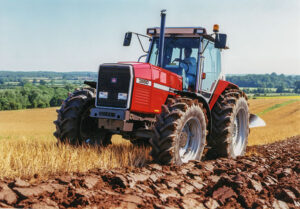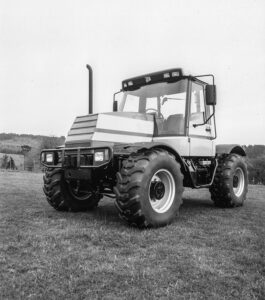Celebrating a lifetime of machinery
26th December 2022
Respected Farmers Guide contributor, Mike Williams, is hanging up his Power on the Land hat after many years. Here, Mike reflects on his decades spent as a machinery journalist.

A 2022 addition to the Claas big square baler range equipped to provide a fine chopping action.
I have been lucky. Writing about tractors and machinery for farming magazines can be a good way for someone with an interest in power farming progress to keep up to date – and my writing career has been a long one.
My first contact with advanced new farm equipment technology came before I started my writing career. I was still a student when agricultural engineers at Reading University completed the development of the world’s first driverless robot tractor during the mid-1950s, and the tractor was taken to one of the university farms where I was among the students forming the first audience to see it perform in a field.
The guidance equipment, which was attached to an International Harvester tractor, followed a network of buried wires carrying signals to control the steering and other functions such as starting, stopping and speed adjustment.
The guidance system performed well, but the student audience was not impressed, partly because of the tractor’s performance limitations and also because of the cost of installing and maintaining the guide wires. Our negative verdict was supported when a commercially produced version of the robot tractor was available for sale a few years later, and attracted little interest.
Driver safety improvements

Driver safety and comfort have become important factors when choosing a new tractor.
Probably the most welcome mechanisation development I have seen during my writing career has been the improvements to driver safety and comfort; a development that has applied generally to self-propelled equipment, but particularly to tractors. The tractors I drove when I was employed as a harvest help in the early 1950s lacked a cab, and a padded seat was an unusual luxury, but change was on the way as driver comfort became an increasingly important sales feature.
Farmers and contractors were increasingly willing to pay for a cab that could improve their own tractor driving comfort, and employees were more willing to continue working in adverse weather if they were offered cab comfort including a padded seat, and with heating and sound insulation. Noise levels in tractor cabs had become an increasingly significant issue during the 1960s, followed in the 1970s by the introduction of regulations aimed at limiting driver exposure to noise in the cab.
Four-wheel drive
While driver comfort has been on a welcome upward trend during my working career, other growth areas have included the demand for the extra traction efficiency of 4wd. Putting the power through four wheels instead of two can be a much more efficient method of turning engine power into drawbar pull, with advances in the structural technology of tyres allowing work to continue in a wider range of ground conditions.
The loser in this situation has been the demand for tracklayers which have experienced a sales downturn in the UK tractor market, while some of the benefits available from rubber tracks have recently increased their popularity on combine harvesters.
Industry ups and downs
I have been writing about various aspects of power farming since the early 1960s. The industry has suffered both ups and downs, and when my connection started there were still some results from the post-war sales surge which had attracted new names into tractor and machinery manufacturing.
Some of the sales expansion had been caused by equipment shortages created when tractor and machinery manufacturers were required to switch to military equipment production during the war years. Post-war Britain was also an attractive destination for American tractor companies wanting direct access to what was then the British Empire and, later, to the European market.
The list of American companies starting tractor manufacturing or assembly activities in the UK during the period after the war ended included Allis-Chalmers, Case, International Harvester and Minneapolis-Moline, and they joined Ford and Massey-Harris who were already established as leading UK manufacturers.

This picture was issued when the JCB Fastrac made its first appearance to the farming press.
Some of the manufacturing expansion was also due to a surge of new British-owned companies that started tractor production after the war, many of them making complete tractors while others developed conversions based on standard production models.
The failure rate among the British newcomers in both categories was high with most of the companies disappearing as the market became increasingly competitive, but a notable exception is JCB with its ongoing Fastrac success, and there have also been a number of continuing long-term successes for British companies building self-propelled machinery, including sprayers.
Although tractors and self-propelled equipment have remained at the forefront of my interest during my working career, I have also had plenty of opportunity to observe progress in field machinery generally.
Balers have remained a special interest, probably because of the time I spent as a harvest helper handling conventional straw bales one at a time with a pitchfork. Machines for grouping small bales for handling in flat-eights or other batched group arrangements have made a big contribution to handling efficiency for straw and hay, and these must be welcome developments for those who work on farms, followed by further advances through the introduction of big bales, both round and square. I remember an occasion when illness kept another harvest helper at home for a day or two, and I had to work single-handedly with a pitchfork loading straw bales into a trailer in an 80-acre field. My work rate was not impressive – but at least the situation won an apology from the farm manager.
In spite of a dislike of bale handling with a pitchfork, mine has been a career with more ups than downs – and thanks go to Farmers Guide and other publications for providing the opportunities to benefit me.
